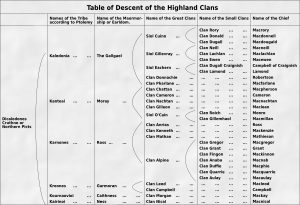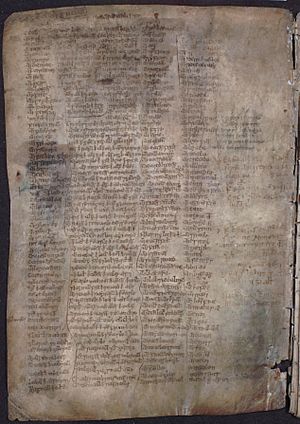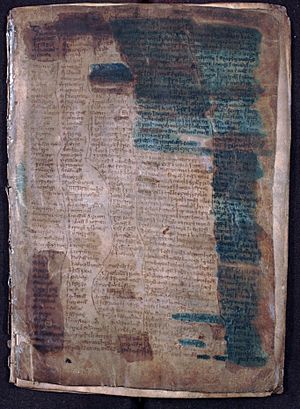MS 1467 facts for kids
MS 1467 is an old book, or manuscript, written in Gaelic a long time ago. It was once called MS 1450. This special book holds many family trees, called pedigrees, for important people and clans in Scotland.
People started publishing copies of these family trees in the early 1800s. These copies have been used by writers who study the history of Scottish clans ever since. However, the copies and translations from the 1800s are not very accurate. Even today, there isn't a new, complete, and accurate version of this important manuscript.
Contents
What is MS 1467?
The manuscript known as MS 1467 is an old Gaelic book kept at the National Library of Scotland. It is part of a larger document called MS 72.1.1, which actually contains two manuscripts bound together. MS 1467 is the first part, covering pages 1 to 9. The second part is known as the Broad Book, which was written in 1425.
MS 1467 is made from vellum, which is a type of treated animal skin used for writing on. It measures about 23 by 19 centimeters (about 9 by 7.5 inches). A person named Dubhghall Albanach mac mhic Cathail wrote it. Experts believe he was likely from a family of traditional poets and storytellers called the MacMhuirich bardic family, and he probably came from Kintyre in Scotland. Another expert, Wilson McLeod, thinks Dubhghall Albanach wrote the manuscript in Ballybothy, which is in County Tipperary, Republic of Ireland.
What's Inside the Manuscript?
The first page of MS 1467 is filled with family trees for important people and families. The rest of the pages (from 2 to 9) contain different kinds of writings. These include a sermon (a religious speech) said to be by King Solomon, stories about the deaths of important figures like St Philip, St Andrew, St James, Christ, and John the Baptist. There's also a part of a book called Liber Scintillarum, which was translated from Latin, a poem about how John the Baptist was executed, some religious stories, and an account of St Paphnutius.
These later pages are written much more carefully than the first page with the family trees. This might mean that Dubhghall Albanach was more interested in religious topics than in writing down family histories.
Damage to the Manuscript
The writing of the family trees in MS 1467 is not very clear. In some parts, the writing looks like messy scratches or scribbles. Other marks and stains have also damaged the manuscript over time. These marks came from the way the book's covers were made.
In the 1800s, a famous Scottish historian named William Forbes Skene tried to make some hard-to-read parts of the text clearer. He used chemicals on the manuscript. Sadly, this caused brown, green, and blue stains to appear on the pages. While these stains sometimes made the text a bit easier to read, they also made it impossible to examine the manuscript using ultra-violet light later on.
How We Know About MS 1467
Experts believe that the family trees in MS 1467 were copied from an even older text, possibly from around 1400. The way these family trees are put together suggests they were written quickly and not very neatly.
The manuscript was first owned by a Rev. John Beaton. Later, it went to Rev. David Malcolm, who gave it to the Edinburgh Philosophical Society in 1738. The Broad Book also came into the society's possession later, and the two manuscripts were bound together in 1813.
Early Publications and Mistakes
In 1847, a group called the Iona Club published a collection of papers. This collection included a section called "Genealogies of the Highland Clans, extracted from Ancient Gaelic MSS." This section had a copy and translation of MS 1467, with notes by William Forbes Skene. At that time, the manuscript was called "Gaelic MS, written circa A.D. 1450." The publication said the manuscript was found by accident the year before. The last page was very faded and almost impossible to read.
At first, people thought the manuscript was written around 1450. But after more careful study, the actual date of 1467 was found written inside the manuscript itself.
Later, in 1880, Skene published parts of the manuscript again in his large work called Celtic Scotland. He called it "Legendary Descent of the Highland Clans, according to Irish MSS." A slightly changed version was published ten years later. In his Celtic Scotland copy, Skene left out many words, phrases, and even whole family trees that he couldn't read or understand. He also made some corrections to his earlier copies. However, he also added text from other sources. Because of this, many writers have mistakenly thought that Skene's version was an exact copy of MS 1467.
For a long time, from the 1800s to the early 1900s, people thought the manuscript was written by someone from the Maclachlan family. This was because the family tree for Clanlachlan is much more detailed than others, and it even mentions marriages within that clan. People thought the manuscript might have been part of the Kilbride Collection, which the Maclachlans of Kilbride had kept for many years.
Today, there is still no new, complete, and accurate scholarly version of this manuscript.
How MS 1467 Was Used in the 1800s

A Gaelic scholar named Alexander Macbain, who often disagreed with Skene, said that Skene relied too much on the family trees in MS 1467. He warned that these family trees should be used carefully. Over the years, other experts have agreed. For example, in the early 1900s, writer George Eyre-Todd said that Skene had a "fatal tendency to create theories based on not enough evidence, and his strong belief in the MS. of 1467."
More recently, David Sellar confirmed that Skene's copy of the manuscript was far from perfect. Sellar pointed out that Skene's "Table of the Descent of the Highland Clans," found in his book Highlanders, is "very speculative" and misleading. This is because it was partly based on inaccurate copies from the manuscript. Even so, Sellar noted that the ideas Skene got from this manuscript were trusted for too long.
List of Family Trees
The manuscript contains family trees (pedigrees) for the following clans and individuals:
| Gaelic | English | Notes |
|---|---|---|
| Caimbeul | Campbell | The earliest known family tree that says the clan came from "British" ancestors (like Uther Pendragon and Arthur) |
| Camshron | Cameron | |
| Clann Eóghain na h-Oitrich | Clan Ewen of Otter | Includes an early family tree. |
| Clann Ghille Ádhagáin | MacLennan | |
| Clann Ghille Eadhráin | ||
| Clann Raghnaill etc. | Macdonald of Clanranald etc. | |
| Clann Shomhairle | Macdougall | |
| Dáibhidh, rí Alba | David I, King of Scotland | |
| Iarla Leamhna | Earl of Lennox | The ancestors of Duncan, Earl of Lennox. |
| Lulach, rí Alba | Lulach, king of Scotland | |
| Mac an Aba Uaine | ||
| Mac an Tóisigh | Mackintosh, Clan Chattan | |
| Mac Aoidh Ugadail | MacKay of Ugadale | |
| Mac Beathadh, rí Alba | Macbeth, king of Scotland | |
| Mac Cainnigh | Mackenzie | |
| Mac Dhomhnaill | Macdonald | |
| Mac Dhubhghaill | Macdougall | |
| Mac Dhuibhshithe | Macfie | |
| Mac Eichthighearna | MacEacharn | |
| Mac Fhinnghuine | Mackinnon | |
| Mac Gabharáin Earca | MacLennan | |
| Mac Ghille Anfaigh, faic Camshron | ||
| Mac Ghille Eadhráin | ||
| Mac Ghilleoin | Maclean | |
| Mac Gille Ainnrias | Gillanders | |
| Mac Griogair | MacGregor | |
| Mac Guaire | MacQuarrie | |
| Mac Labhartaigh ? | ||
| Mac Lachlainn | Maclachlan | |
| Mac Ladhmainn | Lamont | |
| Mac Mathghamhna | Matheson | |
| Mac Mhaoilein | MacMillan | |
| Mac Neacail | MacNeacail | |
| Mac Neachtáin | Macnaghten | |
| Mac Ruaidhrí | MacRuairi | |
| Mac Shomhairle | MacSorley of Monydrain |
See also
- Fearghus Ó Fearghail (fl. c. 1550)



